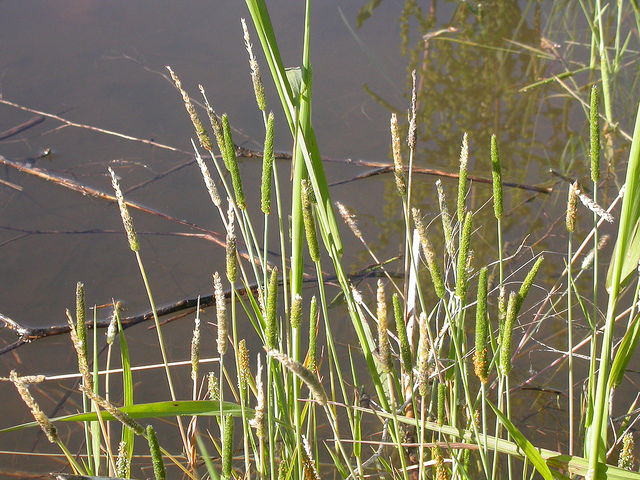Map Snapshot



7 Records
Status
The variety aequalis is being spread via agricultural equipment on the Eastern Shore, where it is likely not native (Terrell & Peterson, 2009).
Seasonality Snapshot
Source: Wikipedia
| Alopecurus aequalis | |
|---|---|

| |
| Scientific classification | |
| Kingdom: | Plantae |
| Clade: | Tracheophytes |
| Clade: | Angiosperms |
| Clade: | Monocots |
| Clade: | Commelinids |
| Order: | Poales |
| Family: | Poaceae |
| Subfamily: | Pooideae |
| Genus: | Alopecurus |
| Species: | A. aequalis
|
| Binomial name | |
| Alopecurus aequalis | |
| Synonyms | |
| |
Alopecurus aequalis is a common species of grass known as shortawn foxtail or orange foxtail.[3] It is native to much of the temperate Northern Hemisphere from Eurasia to North America. It is most commonly found in areas near fresh water, such as the margins of ponds and ditches.[4]
Description
[edit]This perennial bunchgrass is variable in appearance. It produces bunches of erect stems between 20 and about 70 centimeters in height.[5] The leaves are 2–15 cm long; the basal leaves are the longest and the few stem leaves are long-sheathing.[5] The cylindrical inflorescence is a few centimeters long and blooms with white to yellow to bright orange anthers about 0.5-0.8 mm long.[6]
The leaf blades are narrow, about 1–8 mm wide. The flowers are attached to branches, rather than the main axis of the inflorescence.[7]
Ecology
[edit]A. aequalis has a C3 metabolism, grows best in full to partial sun, and can tolerate shallow standing water for up to two months during the growing season.[8]
One variety of this species, var. sonomensis, is a rare California endemic grass which is federally listed as an endangered species of the United States.[9]
References
[edit]- ^ Lansdown, R.V. (2014). "Alopecurus aequalis". IUCN Red List of Threatened Species. 2014: e.T164156A1025862. doi:10.2305/IUCN.UK.2014-1.RLTS.T164156A1025862.en. Retrieved 20 November 2021.
- ^ "NatureServe Explorer". Retrieved 2021-05-27.
- ^ BSBI List 2007 (xls). Botanical Society of Britain and Ireland. Archived from the original (xls) on 2015-06-26. Retrieved 2014-10-17.
- ^ "Alopecurus aequalis | Online Atlas of the British and Irish Flora". www.brc.ac.uk. Retrieved 2021-05-27.
- ^ a b "Alopecurus aequalis (Shortawn Foxtail): Minnesota Wildflowers". www.minnesotawildflowers.info. Retrieved 2021-05-27.
- ^ "Alopecurus aequalis in Flora of China @ efloras.org". www.efloras.org. Retrieved 2021-05-27.
- ^ "Alopecurus aequalis (short-awned meadow-foxtail): Go Botany". gobotany.nativeplanttrust.org. Retrieved 2021-05-27.
- ^ "Short-Awned Foxtail (Alopecurus aequalis)". www.illinoiswildflowers.info. Retrieved 2021-05-27.
- ^ "Determination of Endangered Status for Nine Plants From the Grasslands or Mesic Areas of the Central Coast of California" (PDF). Federal Register. United States Fish and Wildlife Service. October 22, 1997. Retrieved November 6, 2013.
External links
[edit]


